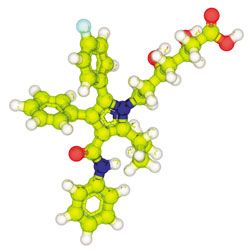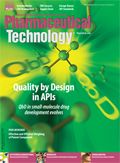Advancing Chiral Chemistry in Pharmaceutical Synthesis
Developments involve stereoretentive cross-coupling, enantioselective alcohol silylation, strategies for amplifying signals in circular dichroism spectroscopy, and a synthetic route for the natural product ingenol.

Chiral chemistry plays an important role in pharmaceutical development and manufacturing. Strategies in asymmetric synthesis to produce single-enantiomer drugs as well as methods for detecting and quantifying chirality are important tools for pharmaceutical chemists. Some recent developments involve stereoretentive cross-coupling for producing libraries of single enantiomers, an approach in enantioselective alcohol silylation, strategies for amplifying signals in circular dichroism spectroscopy, and a synthetic route to the natural product ingenol.
Stereoretentive cross-coupling
Mark R. Biscoe, assistant professor of chemistry at the City College of New York (CCNY), and his team recently reported on a new method for preparing libraries of single-enantiomer molecules for therapeutic and toxicity studies that is faster and potentially less costly than methods now used in the pharmaceutical industry, according to a Aug. 15, 2013 CCNY press release. Specifically, the researchers developed a general palladium-catalyzed process for the stereoretentive cross-coupling of secondary alkyl azastannatrane nucleophiles with aryl chlorides, bromides, iodides, and triflates (1). The researchers reported that coupling partners with a wide range of electronic characteristics were well tolerated and that the reaction occurred with minimal isomerization of the secondary alkyltin nucleophile (1). The researchers assert that the process constituted the first general method to use secondary alkyltin reagents in cross-coupling reactions (1).
Enantioselective alcohol silylation
Researchers at Boston College (BC) reported on a new computational approach for enantioselective alcohol silylation (2) that reduced the reaction time to less than one hour, down from a period of two to five days, reduced catalyst loading, and produced an overall more efficient reaction, according to a July 2013 BC press release. Based on a computational projection, the researchers used cocatalysts to achieve the reaction improvements in enantioselective silyl protection of alcohols promoted by a combination of chiral and achiral Lewis basic catalysts (2). The researchers used a cocatalyst model involving two Lewis base molecules adding the achiral molecule to an already present chiral molecule. These cocatalysts operated in concert, with the chiral molecule activating an alcohol, and the additional achiral molecule, from commercially available 5-ethylthiotetrazole, activating silicon, according to the BC release. Identifying the influence of ethylthiotetrazole was a key component and provided the researchers the ability to effectively control the interplay between the cocatalysts. Together, the Lewis bases served as a closely related Brønsted base to allow the catalyst to work faster while retaining high enantioselectivity.
“The bottom line is the reaction goes a lot faster,” said Marc Snapper, professor of chemistry at BC, in the BC release. “The practical advance is adding the tetrazole, which greatly accelerated the pace of the reaction by doing a much better job activating the silicon reaction partner.” The BC researchers suggest that the new conceptualization of the catalyst could lead to the development of new processes that require separate and independently operational Lewis basic cocatalysts, which can overcome the overlapping functions of cocatalysts and eliminate detrimental effects on the production of new molecules with high enantioselectivity (2).
Nanotechnology in discerning chirality
Researchers at the US Department of Energy’s Brookhaven National Laboratory (BNL) and Ohio University have developed a simpler way to discern chirality by using gold and silver cubic nanoparticles to amplify the difference in the enantiomers to circularly polarised light, according to a June 26, 2013 BNL press release. The researchers showed that nonchiral nanoparticles, specifically gold/silver core/shell nanocubes, can act as plasmonic reporters of chirality for attached molecules by providing two orders of magnitude circular dichroism enhancement in a near-visible region (3).
“Our discovery and methods based on this research could be extremely useful for the characterization of biomolecular interactions with drugs, probing protein folding, and in other applications where stereometric properties are important,” said Oleg Gang, a researcher at Brookhaven’s Center for Functional Nanomaterials in the BNL release. “We could use this same approach to monitor conformational changes in biomolecules under varying environmental conditions, such as temperature--and also to fabricate nano-objects that exhibit a chiral response to light, which could then be used as new kinds of nanoscale sensors.”
The use of nanoparticles to amplify the signal was done to overcome the weak signal when applying circular dichroism spectroscopy in the ultraviolet range for chiral molecules. The researchers were guided by experimental work that showed that coupling certain molecules with metallic nanoparticles would increase their response to light (4) as well as theoretical work that suggested that the plasmonic particles, which induce a collective oscillation of the material’s conductive electrons to create stronger absorption of a particular wavelength, could move the signal into the visible spectrum, where it would be easier to measure, according to the BNL release.
The researchers experimented with different shapes and compositions of nanoparticles and found that cubes with a gold center surrounded by a silver shell are not only able to show a chiral optical signal in the near-visible range, but also were effective signal amplifiers. For their test biomolecule, they used synthetic strands of DNA. When DNA was attached to the silver-coated nanocubes, the signal was approximately 100 times stronger than it was for free DNA in the solution, according to the BNL release. The observed amplification of the circular dichroism signal is a consequence of the interaction between the plasmonic particles and the energy absorbing-electrons within the DNA-nanocube complex, according to the BNL release. The researchers note that the work can serve as a platform for ultrasensitive sensing of chiral molecules and their transformations in synthetic, biomedical and pharmaceutical applications.
In another development, researchers at Harvard University, the Center for Free-Electron Laser Science (CFEL), and the Max Planck Institute in Germany reported on enantiomer-specific detection of chiral molecules by microwave spectroscopy (5, 6). The approach sought to overcome limitations in circular dichroism and vibrational circular dichroism spectroscopy, which are commonly used in analysing chiral molecules, but which produce weak signals and require high sample densities (5, 6). The researchers carried out nonlinear resonant phase-sensitive microwave spectroscopy of gas-phase samples in the presence of an adiabatically switched nonresonant orthogonal electric field. They used this technique to map the enantiomer-dependent sign of an electric dipole Rabi frequency onto the phase of emitted microwave radiation (5, 6) and described how this approach can be used for determining the chirality of cold gas-phase molecules. They implemented the approach experimentally to distinguish between the S and R enantiomers of 1,2-propanediol and their racemic mixture. “We can soon measure mixtures of different compounds and determine the enantiomer ratios of each,” said Melanie Schnell, co-author of the study in a CFEL release. The researchers plan to apply the technique in a broadband spectrometer at CFEL that could measure the enantiomer ratios in mixtures of substances, and longer term, the method opens a way for separating enantiomers (6).
Synthesis of natural products
Natural products are well-established sources for drug candidates but developing synthetic routes to natural products can often pose a problem. Scientists at The Scripps Research Institute (TSRI) recently reported on their work in developing what they characterize as the first efficient chemical synthesis of ingenol, a plant-derived compound with anticancer potential, according to an Aug. 1, 2013 TSRI press release. The work enables the synthesis of various ingenol derivatives and also sets the stage for the commercial production of ingenol mebutate, the API in Picato, a drug to treat actinic keratosis, a common precursor to nonmelanoma skin cancer. Picato was approved by the FDA and the European Medicines Agency in 2012.
Ingenol mebutate, a macrocyclic diterpene ester, is a purified ingenol angelate extracted from the aerial parts of Euphorbia peplus plant. The molecule has eight chiral centers and one “nonrestricted” double bond, thus, there is a theoretical possibility of up to 512 stereoisomers (7). The ingenol mebutate is obtained from the dried, milled aerial parts of the plant by extraction followed by a series of purification steps. The final step of the process involves crystallization (7). In late 2011, the drug’s manufacturer, the Danish pharmaceutical company LEO Pharma, collaborated with TSRI to develop an efficient way to synthesize ingenol mebutate and ingenol derivatives. The scientists developed a stereocontrolled synthesis of (+)-ingenol in 14 steps from inexpensive (+)-3-carene and used a two-phase design (8). The researchers assert the results validate that two-phase terpene total synthesis is an alternative to isolation or bioengineering for preparing polyoxygenated terpenoids (8).
References
1. M.R. Biscoe et al., Nat. Chem. 5 (7) 607-612 (2013).
2. N. Melville et al., Nat. Chem. online, DOI10.1038/nchem.1708, July 28, 2013.
3. O. Gang et al., Nano Lett. 13 (7) 3145-3151 (2013).
4. M.M. Maye, O Gang, and M. Cotlet, Chem. Commun. 46 (33) 6111-6113 (2010).
5. D. Patterson, M. Schnell, and J.M. Doyle, Nature 497 (7450) 475-477 (2013).
6. P. Van Arnum, Pharm. Technol. 37 (6) 46 (2013).
7. EMA, “Assessment Report: Picato” (London, Sept. 20, 2012).
8. P.S. Baran et al., Science, online, DOI: 10.1126/science.1241606, Aug. 1, 2013.
About the Author
Patricia Van Arnum is a executive editor of Pharmaceutical Technology, 485 Route One South, Bldg F, Ste 210, Iselin, NJ 08830 tel. 732.346.3072, pvanarnum@advanstar.com.

Drug Solutions Podcast: A Closer Look at mRNA in Oncology and Vaccines
April 30th 2024In this episode fo the Drug Solutions Podcast, etherna’s vice-president of Technology and Innovation, Stefaan De Koker, discusses the merits and challenges of using mRNA as the foundation for therapeutics in oncology as well as for vaccines.
Drug Solutions Podcast: Applying Appropriate Analytics to Drug Development
March 26th 2024In this episode of the Drug Solutions Podcast, Jan Bekker, Vice President of Business Development, Commercial and Technical Operations at BioCina, discusses the latest analytical tools and their applications in the drug development market.
INTERPHEX 2025: Use of Walk-In Chambers for Bio/Pharma Development and Manufacturing
April 2nd 2025Sitting down with the PharmTech Group at INTERPHEX 2025, Christopher Murphy, director of Global Business Development and Service Customer Support at Environmental Specialties, discusses the design and critical role of walk-in chambers in the bio/pharmaceutical industry.